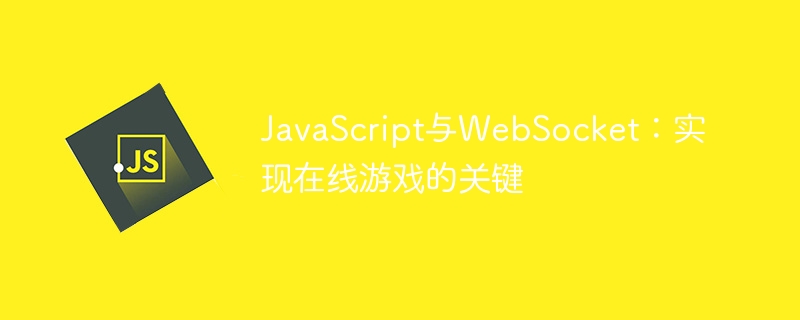Home >Web Front-end >JS Tutorial >JavaScript and WebSocket: the key to online gaming
JavaScript and WebSocket: the key to online gaming
- WBOYWBOYWBOYWBOYWBOYWBOYWBOYWBOYWBOYWBOYWBOYWBOYWBOriginal
- 2023-12-17 08:11:30811browse

JavaScript and WebSocket: The key to realizing online games
Introduction
With the rapid development of the Internet, online games are becoming more and more popular . To realize a high-quality online game, in addition to the design of game logic and exquisite graphics, a stable and reliable communication method is also needed. JavaScript and WebSocket are the key technologies for realizing online games.
1. The role of JavaScript
JavaScript is a scripting language that can achieve dynamic interaction in web pages. In online games, JavaScript can be used to handle game logic, such as character movement, skill release, collision detection, etc. At the same time, it can also realize data synchronization, chat system and other functions in multiplayer games through communication with the back-end server.
The advantage of JavaScript is its cross-platform nature and flexibility. Since it runs in almost all modern browsers and is tightly integrated with HTML and CSS, developers can easily develop games for different devices. In addition, JavaScript also has a wealth of third-party libraries and frameworks, such as Phaser, PixiJS, etc., which can greatly simplify the game development process.
2. Overview of WebSocket
WebSocket is a TCP-based network protocol that can provide two-way communication functions. Compared with the traditional HTTP protocol, WebSocket has lower latency and higher throughput, which is very suitable for online games with high real-time requirements.
WebSocket works by establishing a long connection between the browser and the server to achieve real-time communication. In the game, when a player performs an operation, the client will send relevant data to the server, and the server will process the data after receiving it and broadcast the results to other players. This way, the game state of all players is always in sync.
3. Use WebSocket to implement online games
Below we will demonstrate how to use JavaScript and WebSocket to write a simple online game.
First, on the front end, we need to write a JavaScript client to handle the game logic and code to communicate with the server. For example, we can use the following code:
// 创建WebSocket对象
var socket = new WebSocket("ws://localhost:8080");
// 在连接建立后发送消息
socket.onopen = function() {
socket.send("Hello Server!");
};
// 接收服务器返回的消息
socket.onmessage = function(event) {
console.log("Received message: " + event.data);
};
// 处理连接错误
socket.onerror = function(error) {
console.log("WebSocket error: " + error);
};
// 处理连接关闭
socket.onclose = function(event) {
console.log("WebSocket closed with code: " + event.code);
};On the server side, we can use Node.js to implement the WebSocket server. The following is a simple example:
const WebSocket = require("ws");
// 创建WebSocket服务器
const wss = new WebSocket.Server({ port: 8080 });
// 处理客户端连接
wss.on("connection", function(socket) {
console.log("New client connected");
// 接收客户端发送的消息
socket.on("message", function(message) {
console.log("Received message from client: " + message);
// 广播消息给所有连接的客户端
wss.clients.forEach(function(client) {
client.send(message);
});
});
// 处理连接关闭
socket.on("close", function() {
console.log("Client disconnected");
});
});The above code demonstrates a simple multi-person chat room. When a new client connects, relevant information will be printed out, and the messages sent by the client can be Broadcast to other clients.
Conclusion
JavaScript and WebSocket are key technologies for realizing online games. JavaScript handles game logic and communicates with backend servers, while WebSockets provide the ability for real-time two-way communication. Using these two technologies, functions such as data synchronization and chat systems in online games can be realized. I hope the code examples provided in this article can help readers better understand the application of JavaScript and WebSocket.
The above is the detailed content of JavaScript and WebSocket: the key to online gaming. For more information, please follow other related articles on the PHP Chinese website!

